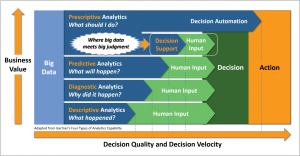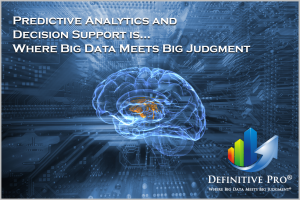Prescriptive Analytics: Where Big Data Meets Big Judgment

As academia and industry try to organize and describe the evolving world of big data analytics, there seems to be little agreement on whether there are three, four, or five types of data analytics. However, most of the models include the four types below and portray them on a continuum that begins with the least advanced, descriptive analytics, and progresses to the most advanced, prescriptive analytics.
- Descriptive Analytics – What happened?
- Diagnostic Analytics – Why did it happen?
- Predictive Analytics – What might happen?
- Prescriptive Analytics – What should we do?
Prescriptive Analytics
 Prescriptive Analytics is considered by many to be the most advanced form of data analytics because it can be used to make specific recommendations to solve a business problem by providing actionable insights. Gartner, Inc. describes prescriptive analytics as a form of advanced analytics characterized by techniques such as graph analysis, simulation, complex event processing, neural networks, recommendation engines, heuristics, and machine learning. Gurobi Optimization, Inc., who builds and supports the leading math programming solvers, describes prescriptive analytics as the application of computational sciences to optimize the set of decisions one should make in a given situation, often using math programming models.
Prescriptive Analytics is considered by many to be the most advanced form of data analytics because it can be used to make specific recommendations to solve a business problem by providing actionable insights. Gartner, Inc. describes prescriptive analytics as a form of advanced analytics characterized by techniques such as graph analysis, simulation, complex event processing, neural networks, recommendation engines, heuristics, and machine learning. Gurobi Optimization, Inc., who builds and supports the leading math programming solvers, describes prescriptive analytics as the application of computational sciences to optimize the set of decisions one should make in a given situation, often using math programming models.
In my April 2018 blog, How Optimization Moves Group Decisions Beyond Good and Better, I shared a partial list of the types of business problems that can be solved using optimization techniques. The list is much larger when considering the full breadth of techniques within prescriptive analytics – including: budgeting, fleet management, inventory management, logistics, patient healthcare, transportation, pricing and revenue management, sales and marketing; and scheduling. Regardless of which problem is being solved or which technique is being applied, using prescriptive analytics to solve business problems is dependent on two things – good data and human judgment. Let’s presume for the moment that we have good clean data, skilled data analysts, and the tools necessary to find trends and provide insights into the data. What then does the role of human judgment play in a data-driven decision?
The Convergence of Prescriptive Analytics and Group Decision Making
In the context of the boardroom, human judgment is brought to bear through some form of group decision-making. Even with bigger and better data, and the use of prescriptive analytics, the decision participants still need to:
- Set the goal at the outset, answering “What problem are we trying to solve?”
- Establish how and when the decision will be made
- Identify who will do the data collection and analysis
- Determine the decision criteria and/or success criteria, and their relative importance
- Allocate sufficient resources (human and financial) to plan and execute the work
- Analyze the insights and proposed solution(s)
- Place a value on the quality of the data and the associated insights
- Identify and evaluate the alternative courses of action
- Build a consensus and make the decision
- Communicate the decision
As such, making an effective business decision requires the convergence of prescriptive analytics and decision support. In short, prescriptive analytics serves as a bridge between the world of big data and group decision-making – it is, where big data meets big judgment.

This is a powerful concept, and one that warrants a closer look. In the figure above, the business value of data analytics increases as we move up the continuum from descriptive analytics to prescriptive analytics. As we move up the continuum, the quality and velocity of decision-making also increases by leveraging the more capable techniques and tools, even while the amount of human input decreases. It’s not until decisions can be fully automated does the role of human input move to near zero.
This model represents a quantum leap forward from the days of relying on nice-looking PowerPoint visuals and Excel reports. When I created Definitive Pro, I did so in recognition that predictive analytics will become mainstream in boardrooms to tap the value of big data. The benefits of high quality and high velocity decision-making will accrue to those who harness the power of big data by integrating prescriptive analytics with the knowledge and wisdom of decision-makers.
A Portfolio Management Example

Selecting a set of alternatives as part of a portfolio management process is a good example of where big data meets big judgment. A portfolio of potential business investments, risks, or cost saving initiatives must first be evaluated against a set of decision criteria to determine the value that each individual alternative contributes to the decision goal. This evaluation may include quantitative and qualitative factors. Within a set of alternatives, there may also be dependencies that exist between two or more of them that need to be factored into a decision. Finally, there may also be investment or funding constraints associated with the alternatives, decision criteria, or portfolio that need to be considered – resulting in the need to make a highly complex decision.
When a highly complex decision requires the inputs and consensus from a group of participants, it becomes even more complex. One of the most effective ways to solve this type of problem is to use a prescriptive analytics tool, such as a mathematical programming solver (i.e., optimizer). An optimizer can help select the most favorable set of alternatives that satisfies all dependencies and constraints by examining every possible combination of alternatives — often within just seconds or minutes –to determine the most effective and efficient solution. The benefits of a single, well-constructed “optimization run” can be significant – perhaps saving millions of dollars. The results of an optimizer can provide a corporate board, investment review board, or decision team with the information that they need to answer the most important question: What should we do?
© 2018 Definitive Business Solutions. All Rights Reserved.
John Sammarco has thirty-five years of experience leading, managing, and consulting to top public and private sector organizations, and has over twenty years of experience in facilitating complex group decisions. John founded Definitive Business Solutions in 2003, which provides world-class group decision-making solutions to increase efficiency, boost ROI, and reduce risk associated with business and technology investments. In 2016, John developed Definitive Pro™, which helps groups build consensus and make multi-criteria decisions.
Definitive, Definitive Pro, and “Where Big Data Meets Big Judgment” are registered trademarks of Definitive Business Solutions, Inc.
